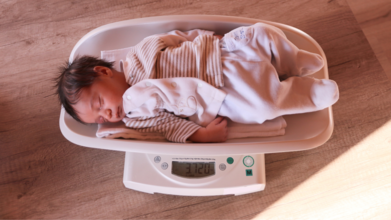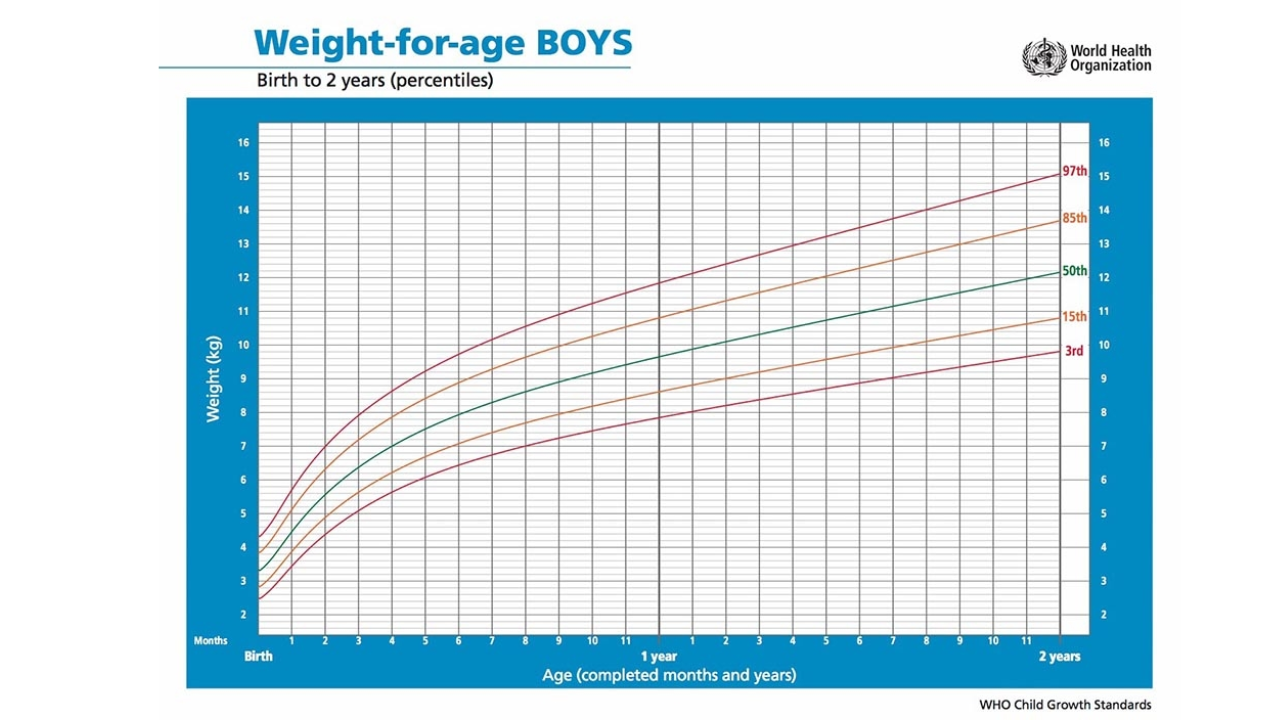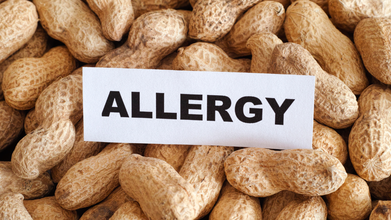- Health Conditions A-Z
- Health & Wellness
- Nutrition
- Fitness
- Health News
- Ayurveda
- Videos
- Medicine A-Z
- Parenting
- Web Stories
How To Decipher What Percentile Your Baby Is Using A Growth Chart?

Credits: Canva
An infant growth chart is a tool that helps parents, doctors, and other health professionals track a baby’s growth over time. By recording key measurements, it gives a clear picture of how your baby is developing compared to healthy growth standards.
The chart records three main measurements:
- Length (height)
- Weight
- Head circumference
These details are plotted so you can see how they change as your baby grows. The vertical axis shows the measurement, while the horizontal axis shows your baby’s age.
Growth charts are more than just numbers. They help assess your baby’s overall health and nutrition. Charts differ for boys and girls, as well as for infants and older children. For babies aged 0 to 2 years, the World Health Organization (WHO) growth standards are used. From 2 years onwards, most states and territories use growth charts based on the US Centers for Disease Control (CDC).
You will usually find a growth chart in your child’s personal health record, which may come in different colours depending on where you live. Parents can also register their child for a My Health Record, a digital platform where healthcare providers can upload growth information and other health updates.
What Are Percentiles?
Percentiles are a common way of showing growth patterns on a chart. They compare your baby’s measurements with those of other babies of the same age.
For example:
- A baby on the 50th percentile for weight is right in the middle. Half of babies the same age weigh less, and half weigh more.
- A baby on the 5th percentile for weight is lighter than 95% of babies that age.
- A baby on the 90th percentile for weight is heavier than 90% of babies that age.
ALSO READ: 99th Percentile Baby: What It Means, Risks, And What Parents Should Know
Every baby grows at their own pace. Some are naturally smaller, others naturally bigger. What matters most is that your baby follows a steady growth pattern over time.
How Growth Charts Are Used

Growth charts help identify whether your baby is following a healthy growth curve. While it is not necessary for a child to match the curve exactly, their growth should generally follow a consistent path.
Your baby is first weighed and measured at birth. It is normal for newborns to lose some weight in the first few days, which is why they are often weighed again at two weeks to check if they have returned to their birth weight. After that, regular growth checks are recommended, usually monthly in the first year.

Routine health checks continue throughout childhood, with growth charts used until a child turns 18. The timing of these checks may vary depending on your state or territory.
Measuring Your Baby
Special infant scales are used for babies up to 20 kilograms. Newborns are weighed lying down, without clothes or a nappy, to ensure accuracy. After the age of 2, children are weighed standing up in light clothing.
Head circumference is measured with a tape measure to track brain and skull growth.
For babies born prematurely, a corrected age is used until they are 2 years old. This adjustment accounts for the number of weeks they were born early. For example, a 4-month-old baby born one month early would have a corrected age of 3 months for growth chart purposes.
When to Seek Advice
A growth chart is a helpful tool, but it is not the only indicator of a baby’s health. Other signs of healthy development include:
- At least five very wet nappies each day
- Pale urine
- Soft, well-sized bowel movements
- Regaining birth weight by 14 days old
- Contentment between feeds
Most babies double their birth weight by around 4 months. If weight gain is slower than expected, it could be due to feeding difficulties, illness, or other health issues.
If your baby’s growth percentile drops significantly or weight gain remains low, speak to your doctor or child health nurse. They can assess the overall growth trend and investigate if needed.
Finally, avoid comparing your baby’s growth to others. Healthy growth looks different for every child, and the goal is steady development through infancy and beyond.
Should Parents Limit Social Media For Teens? New Study Shows It Is Lowering Their Memory Score

(Credit-Canva)
Scientists have found that kids' social media use might be slowing down their brain power. A new study says that spending time on these apps could be hurting how well a tween's mind develops. This research shows that the more time kids spend on platforms like Instagram or TikTok, the worse they might do on school-related tasks later on.
How Does Social Media Affect Our Health?
The researchers found that children aged 9 to 13 who used social media more often did worse on tests that measured skills like reading, memory, and language. They were tested on these abilities two years after the study began. The results were published in a major medical journal called the Journal of the American Medical Association.
The lead scientist, Dr. Jason Nagata, explained that even using social media for a short time each day was connected to poorer results on these brain-power tests. He suggested that the brains of young tweens might be extra sensitive to social media. This means parents need to be careful about when they let their kids start using these apps and how much time they spend on them.
How Did Social Media Affect Kid’s Academics?
To figure this out, the researchers looked at information from over 6,500 children across the country. These kids were all part of the Adolescent Brain Cognitive Development (ABCD) Study, which is the biggest study ever done in the U.S. to track how children's brains grow over time. They sorted the kids into groups based on their social media use:
- Over half (58%) of the kids barely used social media at all.
- More than a third (37%) were using social media for about one extra hour every day by the time they turned 13.
- A small group (6%) were using social media for up to three extra hours a day by age 13.
The children's brain power was measured using special tests created by the National Institutes of Health, which tested things like how well they remember information and understand language. The study found a clear, but small, drop in the test scores for kids who used social media.
- Kids who used social media for just one extra hour a day scored about 1 to 2 points lower on their memory and reading tests.
- Kids who used social media for up to three extra hours a day saw a bigger drop, scoring as much as 4 points lower.
Why Is Important To Restrict Your Child’s Social Media Usage?
Dr. Nagata explained that even though these differences seem small, they are very important because they were seen again and again across the children. Since reading and memory are the most important skills for learning, even these small dips in scores, when seen across thousands of kids, could be a problem for education as a whole.
The scientists think the problem is that social media is so fun and engaging that kids might choose to scroll instead of doing homework or reading. This time shift could be hurting their learning. The researchers stress that creating good screen habits early on can help protect a child’s learning and brain growth.
The results of this study support actions already being taken, such as schools trying to limit student phone use during the day. The findings also provide backing for bigger changes, like making the age limits for social media access even stricter than they are now.
However, the researchers want to be clear about one thing: because they were only watching the kids' behavior (it was an observational study), they can't say for sure that social media causes the lower test scores. They can only say that there is a clear association between the two.
Can Inflammation Affect Fertility? Expert Helps Us Understand the Hidden Connection

Credits: Canva
Chronic inflammation in the body could interrupt with hormones, as well as reproductive hormones and it could also lead to interfere with embryo implantation. As a result, conception could become more difficult for both men and women. Health and Me spoke to expert, Dr Varsha Agarwal, who is a consultant and fertility & IVF specialist at Motherhood Fertility & IVF, Noida.
Here's what she explained.
The Delicate Balance Of Fertility
Fertility depends on a delicate balance of hormones, she noted. Healthy reproductive organs, and proper immune functions are among the most important functions of the human body that results in healthy fertility. However, when the body experiences inflammation, explains Agarwal, this balance can be disrupted. Many individuals struggling with infertility may not even realize that inflammation could be one of the underlying conditions.
Inflammation is the body’s natural response to injury or infection, but when it becomes chronic, it can create an internal environment that isn’t ideal for reproduction. According to Dr. Agarwal, “Chronic inflammation can interfere with hormonal signals, damage reproductive tissues, and even affect how an embryo implants in the uterus. Over time, this can make conception more difficult for both men and women.”
How Does Inflammation Affect Fertility In Women?
In women, inflammation can impact the ovaries, fallopian tubes, and uterus. It could also cause conditions like endometriosis, pelvic inflammatory diseases (PID), and polycystic ovarian syndrome (PCOS). These conditions are often linked with chronic inflammation and could disrupt ovulation, affect egg quality, and even alter the uterine lining. All of these could make conception more difficult.
Dr. Agarwal explains, “Inflammation in the reproductive organs can lead to scarring or blockages in the fallopian tubes, preventing the egg and sperm from meeting. It can also alter the hormonal environment, which may delay or prevent ovulation.”
Does It Also Impact Male Fertility?
Inflammation doesn’t discriminate between men or women. Inflammation in the testicular or prostate area can reduce sperm count, motility, and quality, creating challenges in conception. “In men, oxidative stress triggered by chronic inflammation can damage sperm DNA and reduce fertility potential,” adds Dr. Agarwal.
Lifestyle factors such as poor diet, obesity, smoking, stress, lack of sleep, and exposure to toxins can all worsen inflammation and hormonal imbalances. Over time, these factors can contribute to infertility in both sexes.
What Can Be Done To Manage Inflammation?
Dr Agarwal recommends lifestyle measures like:
- Consuming anti-inflammatory foods: fresh fruits, vegetables, whole grains, nuts, fatty fish rich in omega-3. Avoid processed and fried foods.
- Maintain a healthy weight by exercising daily
- Stay active
- Quit smoking
- Prioritize sleep
- Reduce stress by practicing mindfulness and meditation
“If conception isn’t happening despite regular attempts, it’s vital to consult an expert,” advises Dr. Agarwal. “Get screened for underlying inflammatory or autoimmune conditions early. With timely medical guidance and healthy lifestyle changes, it’s possible to reduce inflammation, restore hormonal balance, and improve fertility naturally and safely.”
Can You Stop Your Kid From Being Allergic To Peanuts? New Study Shows It May Be Possible With These Steps

(Credit-Canva)
Allergies are a major concern for parents, as they can develop at any time. Parents often worry about being in a situation where they cannot help their child. This leads them to be very cautious of certain foods like peanuts, which is a common allergen, according to the American College of Allergy, Asthma and Immunology.
However, there may be a way to reduce the risk of your child developing peanut allergy. According to a new study published in the Pediatrics journal, giving pediatricians a few simple tools significantly increased how often they recommended introducing peanuts to babies early.
This finding is a major victory because it shows a clear way to prevent peanut allergies, which are becoming more and more common in children. This important study was conducted by experts from Northwestern University and Ann & Robert H. Lurie Children's Hospital of Chicago.
What Age Should Kids Start Consuming Peanut Products?
As you may know, allergies happen when your immune system overreacts to something that is usually not harmful. Things like pollen, pet dander and certain foods like peanuts. Some symptoms of allergies can range from sneezing, a runny nose, vomiting or even difficulty breathing.
Harvard health explains that you can develop allergies at any age. Since 2017, official national medical guidelines have told doctors to recommend giving infants peanut-containing foods when they are around 4 to 6 months old. The reason for this early introduction is to actively lower the baby's risk of developing a peanut allergy.
Despite these clear rules, surveys showed that most pediatricians were not consistently following the guidelines. This is a serious issue because peanut allergy is the most common food allergy in children, and it now affects over 2% of all children in the United States, a number that is currently increasing.
How Can We Lower The Rate Of Peanut-Allergies?
The new study tested an intervention where doctors were given three easy-to-use tools:
- A short training video for the doctor's office staff to watch.
- Electronic health record (EHR) prompts—these are reminders that automatically pop up on the computer screen during a check-up.
- Handouts with clear information for the baby's parents.
The results were impressive: in the clinics that used these tools, doctors followed the guidelines 84% of the time for low-risk babies (those without existing eczema or egg allergy). In contrast, the clinics that did not use the tools only followed the guidelines 35% of the time. This means that babies whose doctors used the tools were nearly 15 times more likely to receive this important allergy prevention advice.
What Role Do Doctors Play To Lower Peanut Allergies?
Lead author Dr. Ruchi Gupta emphasized that this extra support for doctors is absolutely essential. Visits for 4- and 6-month-old babies are often very busy, with many things for the doctor to cover in a short time. The simple tools help doctors provide clear, consistent guidance to families despite this time pressure.
Dr. Gupta shared her hope: "We want these conversations to help parents feel confident and secure about introducing peanut products early." The ultimate goal is to use this effective prevention strategy to stop the trend of rising food allergies in the U.S. and protect children's health.
© 2024 Bennett, Coleman & Company Limited

